lights TOYOTA RAV4 PLUG-IN HYBRID 2021 User Guide
[x] Cancel search | Manufacturer: TOYOTA, Model Year: 2021, Model line: RAV4 PLUG-IN HYBRID, Model: TOYOTA RAV4 PLUG-IN HYBRID 2021Pages: 666, PDF Size: 161.28 MB
Page 31 of 666
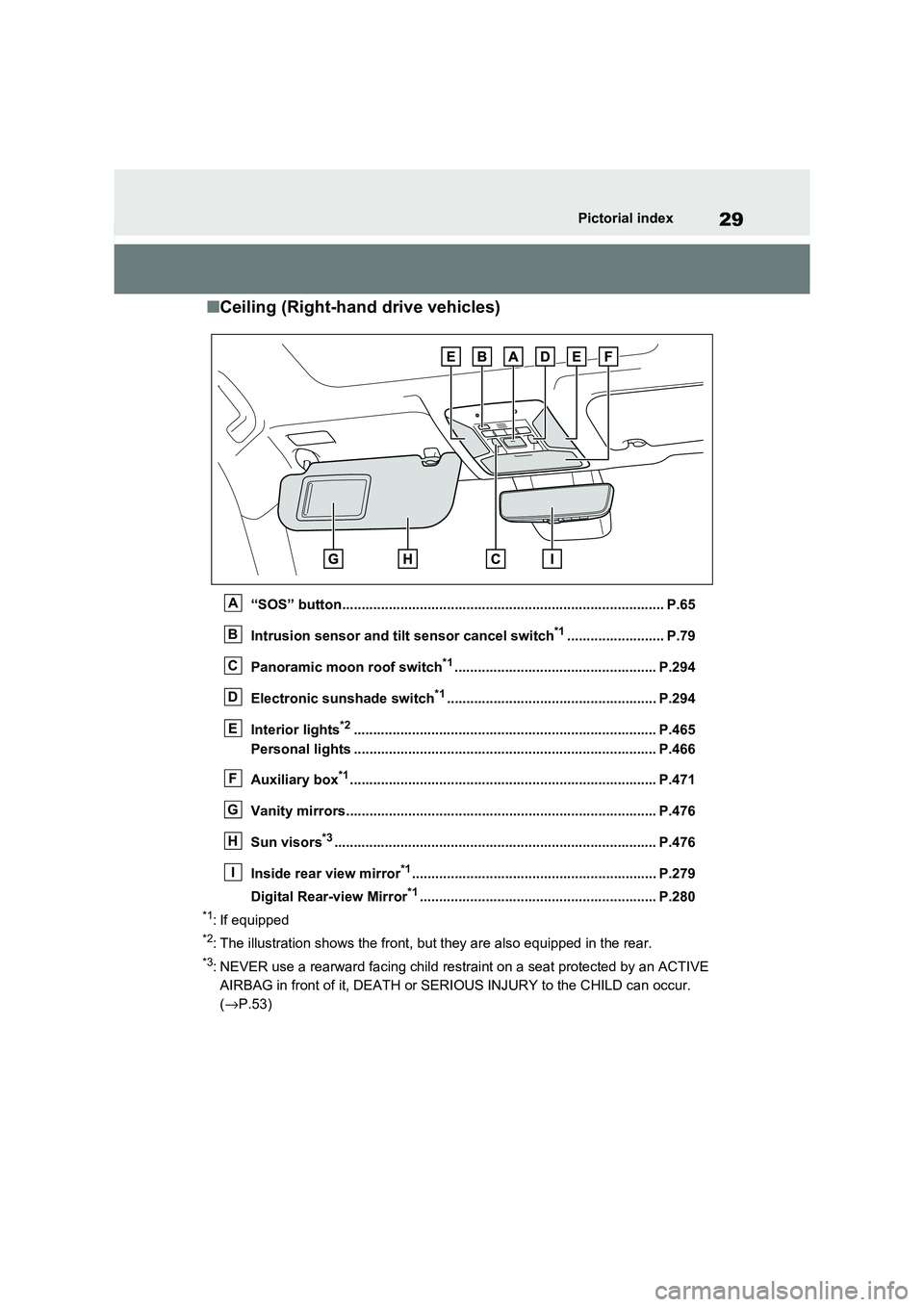
29Pictorial index
■Ceiling (Right-hand drive vehicles)
“SOS” button................................................................................... P.65
Intrusion sensor and tilt sensor cancel switch*1......................... P.79
Panoramic moon roof switch*1.................................................... P.294
Electronic sunshade switch*1...................................................... P.294
Interior lights*2............................................................... ............... P.465
Personal lights ................................................ .............................. P.466
Auxiliary box*1............................................................... ................ P.471
Vanity mirrors................................................. ............................... P.476
Sun visors*3............................................................... .................... P.476
Inside rear view mirror*1............................................................... P.279
Digital Rear-view Mirror*1............................................................. P. 280
*1: If equipped
*2: The illustration shows the front, but they are also equipped in the rear.
*3: NEVER use a rearward facing child restraint on a seat protected by an ACTIVE
AIRBAG in front of it, DEATH or SERIOUS INJURY to the CHILD can occur.
( →P.53)
A
B
C
D
E
F
G
H
I
Page 43 of 666
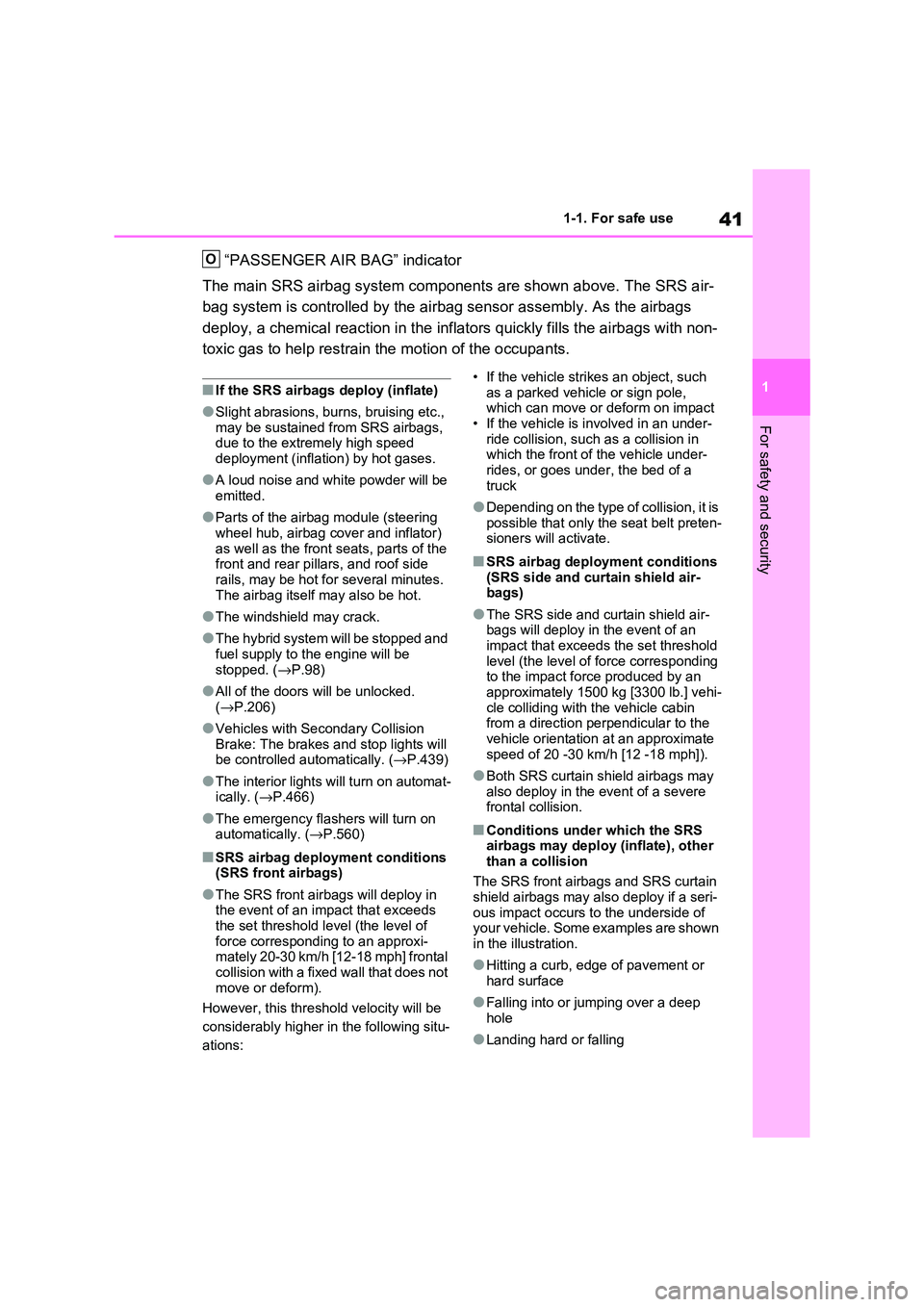
41
1
1-1. For safe use
For safety and security
“PASSENGER AIR BAG” indicator
The main SRS airbag system comp onents are shown above. The SRS air-
bag system is controlled by the airbag sensor assembly. As the airbags
deploy, a chemical reaction in t he inflators quickly fills the airbags with non-
toxic gas to help restrain t he motion of the occupants.
■If the SRS airbags deploy (inflate)
●Slight abrasions, burns, bruising etc.,
may be sustained from SRS airbags, due to the extrem ely high speed
deployment (inflation) by hot gases.
●A loud noise and white powder will be
emitted.
●Parts of the airbag module (steering
wheel hub, airbag cover and inflator)
as well as the fron t seats, parts of the front and rear pillars, and roof side
rails, may be hot for several minutes.
The airbag itself m ay also be hot.
●The windshield may crack.
●The hybrid system will be stopped and
fuel supply to t he engine will be
stopped. ( →P.98)
●All of the doors will be unlocked.
( →P.206)
●Vehicles with Secondary Collision
Brake: The brakes and stop lights will be controlled au tomatically. (→P.439)
●The interior lights will turn on automat- ically. ( →P.466)
●The emergency flashers will turn on automatically. ( →P.560)
■SRS airbag deployment conditions
(SRS front airbags)
●The SRS front airb ags will deploy in
the event of an impact that exceeds
the set threshold level (the level of force corresponding to an approxi -
mately 20-30 km/h [12-18 mph] frontal
collision with a fixed wall that does not move or deform).
However, this threshold velocity will be
considerably higher in the following situ -
ations:
• If the vehicle strikes an object, such as a parked vehicle or sign pole,
which can move or deform on impact
• If the vehicle is involved in an under -
ride collision, such as a collision in which the front of the vehicle under -
rides, or goes under , the bed of a
truck
●Depending on the type of collision, it is
possible that only the seat belt preten - sioners will activate.
■SRS airbag deployment conditions
(SRS side and cu rtain shield air-
bags)
●The SRS side and curtain shield air -
bags will deploy in the event of an impact that exceeds the set threshold
level (the level of force corresponding
to the impact forc e produced by an approximately 1500 kg [3300 lb.] vehi -
cle colliding with the vehicle cabin
from a direction perpendicular to the vehicle orientation at an approximate
speed of 20 -30 km/h [12 -18 mph]).
●Both SRS curtain shield airbags may
also deploy in the event of a severe
frontal collision.
■Conditions under which the SRS airbags may deploy (inflate), other
than a collision
The SRS front airbags and SRS curtain shield airbags may a lso deploy if a seri-
ous impact occurs to the underside of
your vehicle. Some e xamples are shown in the illustration.
●Hitting a curb, edge of pavement or hard surface
●Falling into or jumping over a deep hole
●Landing hard or falling
O
Page 67 of 666
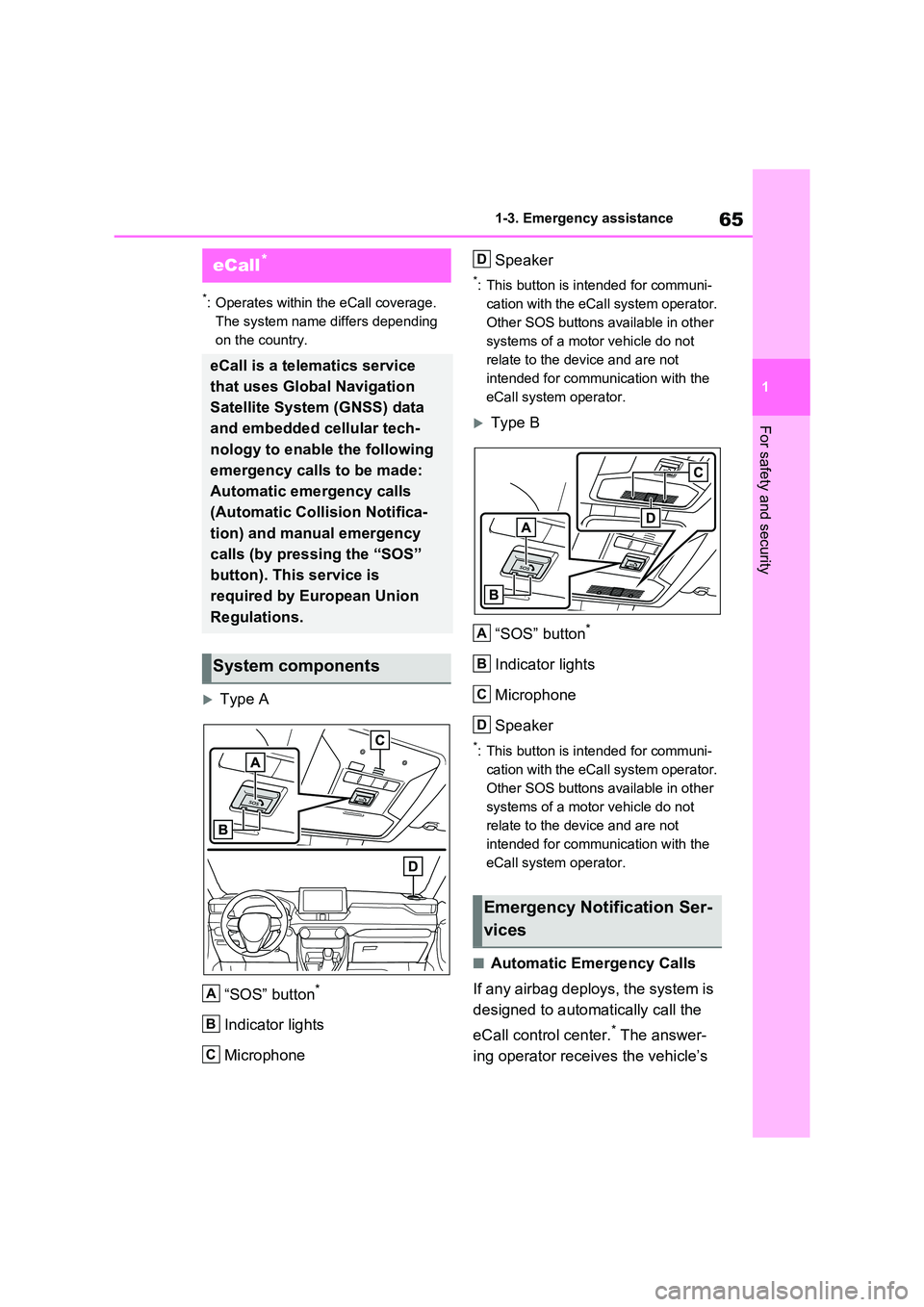
65
1
1-3. Emergency assistance
For safety and security
1-3.Emergency assistance
*: Operates within the eCall coverage.
The system name differs depending
on the country.
Type A
“SOS” button*
Indicator lights
Microphone
Speaker
*: This button is intended for communi -
cation with the eCal l system operator.
Other SOS buttons available in other
systems of a motor vehicle do not
relate to the dev ice and are not
intended for communication with the
eCall system operator.
Type B
“SOS” button*
Indicator lights
Microphone
Speaker
*: This button is intended for communi -
cation with the eCal l system operator.
Other SOS buttons available in other
systems of a motor vehicle do not
relate to the dev ice and are not
intended for communication with the
eCall system operator.
■Automatic Emergency Calls
If any airbag deploys, the system is
designed to automatically call the
eCall control center.* The answer -
ing operator receives the vehicle’s
eCall*
eCall is a telematics service
that uses Global Navigation
Satellite System (GNSS) data
and embedded cellular tech -
nology to enable the following
emergency calls to be made:
Automatic emergency calls
(Automatic Collision Notifica -
tion) and manual emergency
calls (by pressing the “SOS”
button). This service is
required by European Union
Regulations.
System components
A
B
C
Emergency Notification Ser -
vices
D
A
B
C
D
Page 68 of 666
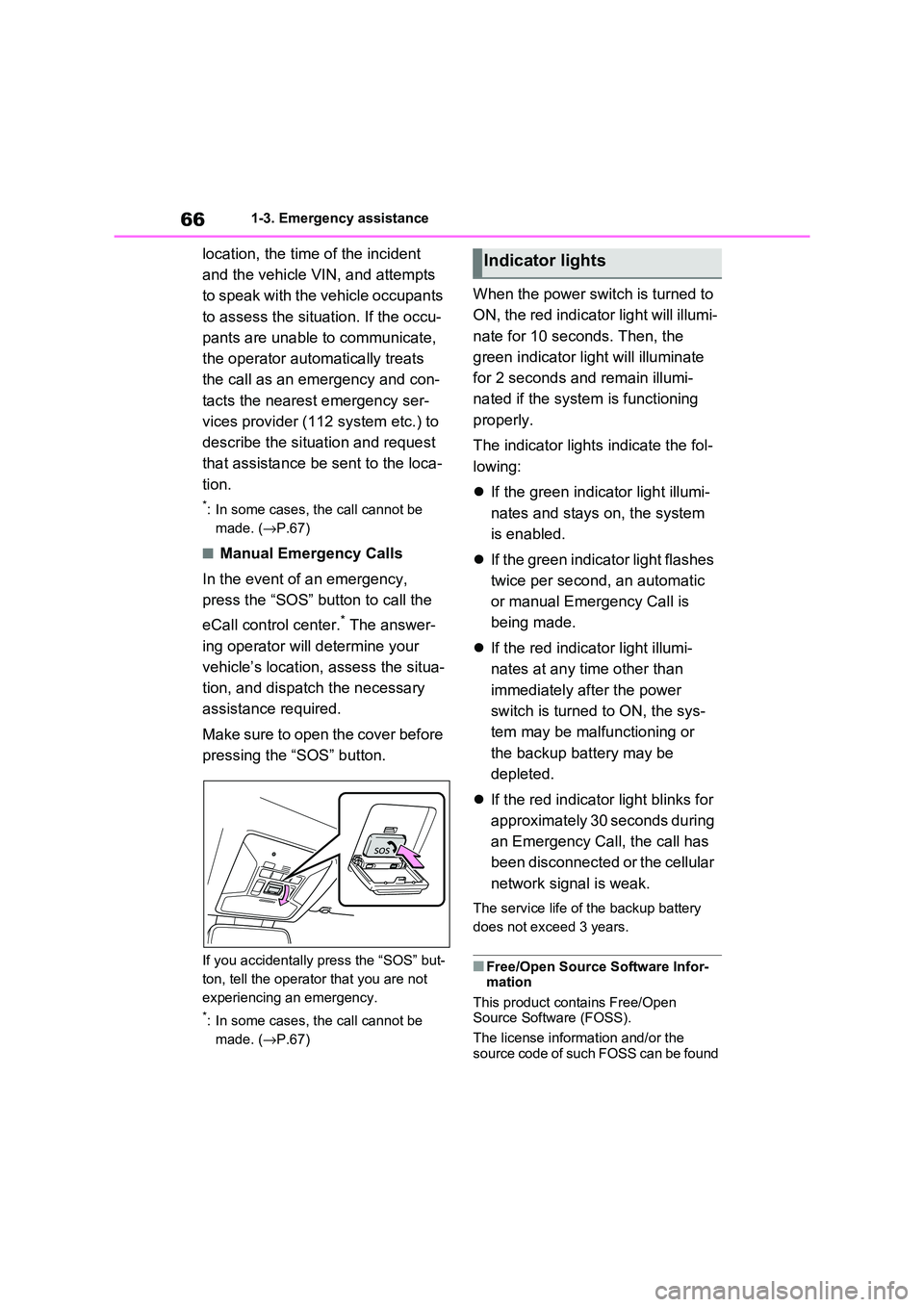
661-3. Emergency assistance
location, the time of the incident
and the vehicle V IN, and attempts
to speak with the vehicle occupants
to assess the situation. If the occu -
pants are unable to communicate,
the operator automatically treats
the call as an emergency and con -
tacts the nearest emergency ser -
vices provider (1 12 system etc.) to
describe the situation and request
that assistance be sent to the loca-
tion.
*: In some cases, the call cannot be
made. ( →P.67)
■Manual Emergency Calls
In the event of an emergency,
press the “SOS” button to call the
eCall control center.* The answer -
ing operator will determine your
vehicle’s location, assess the situa -
tion, and dispatch the necessary
assistance required.
Make sure to open the cover before
pressing the “SOS” button.
If you accidentally p ress the “SOS” but-
ton, tell the operator that you are not
experiencing an emergency.
*: In some cases, the call cannot be
made. ( →P.67)
When the power switch is turned to
ON, the red indicator light will illumi -
nate for 10 seconds. Then, the
green indicator ligh t will illuminate
for 2 seconds and remain illumi -
nated if the system is functioning
properly.
The indicator lights indicate the fol -
lowing:
If the green indicator light illumi-
nates and stays on, the system
is enabled.
If the green indicator light flashes
twice per second, an automatic
or manual Emergency Call is
being made.
If the red indicator light illumi-
nates at any time other than
immediately after the power
switch is turned to ON, the sys -
tem may be malfunctioning or
the backup battery may be
depleted.
If the red indicator light blinks for
approximately 30 seconds during
an Emergency Call, the call has
been disconnected or the cellular
network signal is weak.
The service life of t he backup battery
does not exceed 3 years.
■Free/Open Source Software Infor - mation
This product contains Free/Open
Source Software (FOSS).
The license informa tion and/or the
source code of such FOSS can be found
Indicator lights
Page 69 of 666
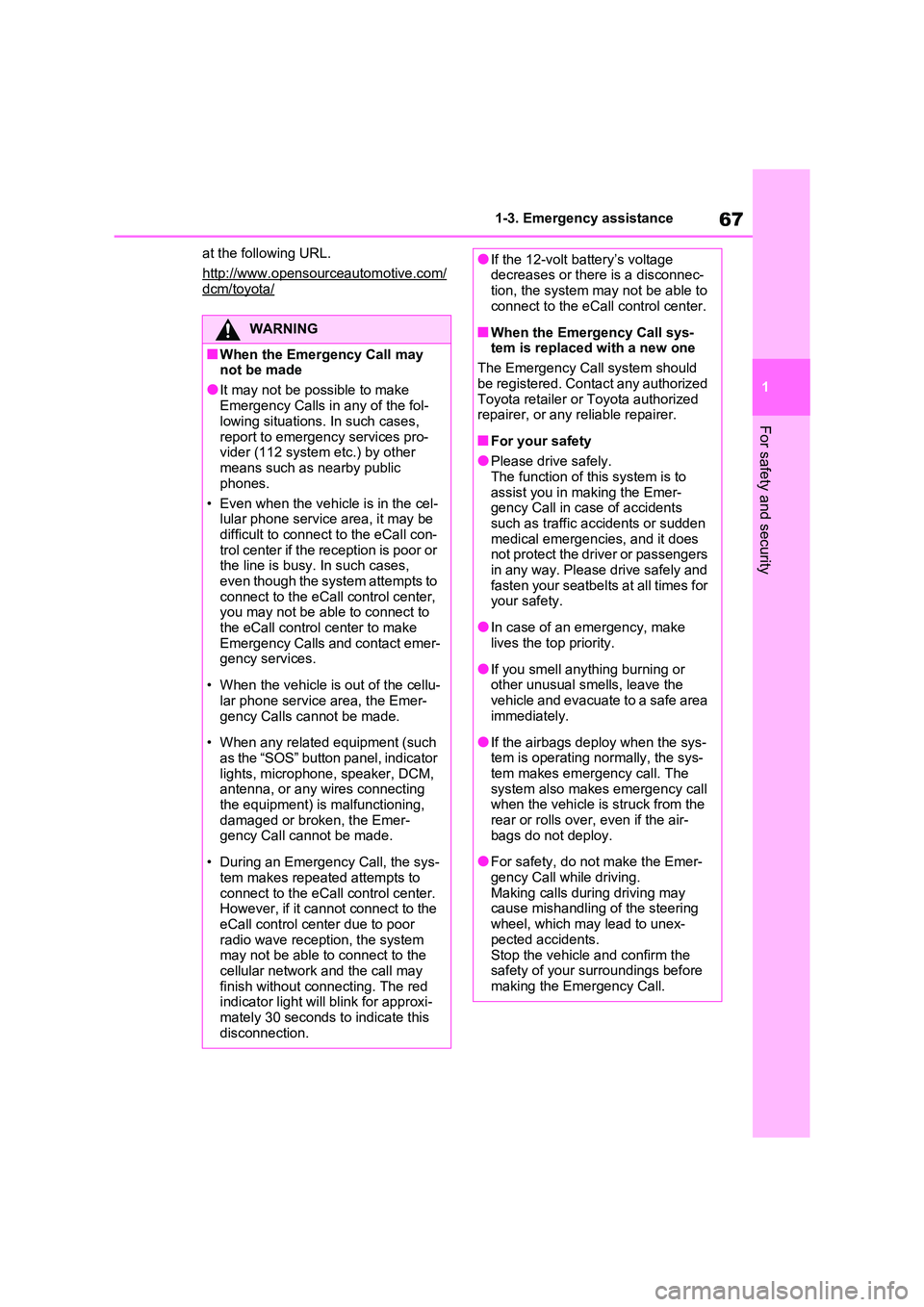
67
1
1-3. Emergency assistance
For safety and security
at the following URL.
http://www.opensourceautomotive.com/dcm/toyota/
WARNING
■When the Emergency Call may
not be made
●It may not be possible to make
Emergency Calls in any of the fol-
lowing situations. In such cases,
report to emergen cy services pro- vider (112 system etc.) by other
means such as nearby public
phones.
• Even when the vehicle is in the cel -
lular phone service area, it may be
difficult to connec t to the eCall con- trol center if the reception is poor or
the line is busy. In such cases,
even though the system attempts to connect to the eCall control center,
you may not be able to connect to
the eCall control center to make Emergency Calls and contact emer -
gency services.
• When the vehicle is out of the cellu -
lar phone service area, the Emer -
gency Calls cannot be made.
• When any related equipment (such
as the “SOS” button panel, indicator lights, microphone, speaker, DCM,
antenna, or any wires connecting
the equipment) is malfunctioning, damaged or broken, the Emer -
gency Call cannot be made.
• During an Emergency Call, the sys -
tem makes repeated attempts to
connect to the eCall control center. However, if it cannot connect to the
eCall control center due to poor
radio wave reception, the system may not be able to connect to the
cellular network and the call may
finish without connecting. The red indicator light will blink for approxi -
mately 30 seconds to indicate this
disconnection.
●If the 12-volt battery’s voltage decreases or there is a disconnec -
tion, the system may not be able to
connect to the eCa ll control center.
■When the Emergency Call sys-
tem is replaced with a new one
The Emergency Call system should
be registered. Contact any authorized
Toyota retailer or Toyota authorized repairer, or any reliable repairer.
■For your safety
●Please drive safely.
The function of t his system is to
assist you in making the Emer - gency Call in case of accidents
such as traffic a ccidents or sudden
medical emergenc ies, and it does not protect the driver or passengers
in any way. Please drive safely and
fasten your seatbelts at all times for your safety.
●In case of an emergency, make lives the top priority.
●If you smell anything burning or other unusual smells, leave the
vehicle and evacuate to a safe area
immediately.
●If the airbags dep loy when the sys-
tem is operating normally, the sys- tem makes emerge ncy call. The
system also makes emergency call
when the vehicle is struck from the rear or rolls over , even if the air-
bags do not deploy.
●For safety, do not make the Emer -
gency Call while driving.
Making calls during driving may cause mishandling of the steering
wheel, which may lead to unex -
pected accidents.
Stop the vehicle and confirm the safety of your su rroundings before
making the Emergency Call.
Page 102 of 666

1002-1. Plug-in hybrid system
Shift the shift lever to D when
stopped at a traffic light, or driving
in heavy traffic etc. Shift the shift
lever to P when parking. When
using the N, there is no positive
effect on fuel consumption. In the
N, the gasoline engine operates but
electricity canno t be generated.
Also, when using the air condition -
ing system, etc., the hybrid battery
(traction battery) power is con -
sumed.
Drive your vehicle smoothly.
Avoid abrupt acceleration and
deceleration. Gradual accelera -
tion and deceler ation will make
more effective use of the electric
motor (traction motor) without
having to use gasoline engine
power.
Avoid repeated acceleration.
Repeated acceleration con -
sumes hybrid battery (traction
battery) power, resulting in poor
fuel consumption. Battery power
can be restored by driving with
the accelerator pedal slightly
released.
Make sure to operate the brakes
gently and a ti mely manner. A
greater amount of electrical energy
can be regenerated when slowing
down.
Repeated acceler ation and decel-
eration, as well as long waits at traf -
fic lights, will lead to high fuel and
electricity consumption. Check traf -
fic reports before leaving and avoid
delays as much as possible. When
driving in a traffic jam, gently
release the brake pedal to allow the
vehicle to move forward slightly
while avoiding overuse of the accel -
erator pedal. Doing so can help
control excessive electricity and
fuel consumption.
Control and maintain the vehicle
at a constant speed. Before stop -
ping at a toll booth or similar,
allow plenty of time to release
the accelerator and gently apply
the brakes. A greater amount of
electrical energy can be regener -
ated when slowing down.
Electricity consumption will
increase significantly when driv -
ing at high speeds in EV mode or
AUTO EV/HV mode. If there will
be a long distance to the next
external charging point after
leaving a freewa y, it is recom-
mended to drive in HV mode
while on the freeway and change
Shift lever operation
Accelerator pedal/brake
pedal operation
When braking
Delays
Highway driving
Page 130 of 666
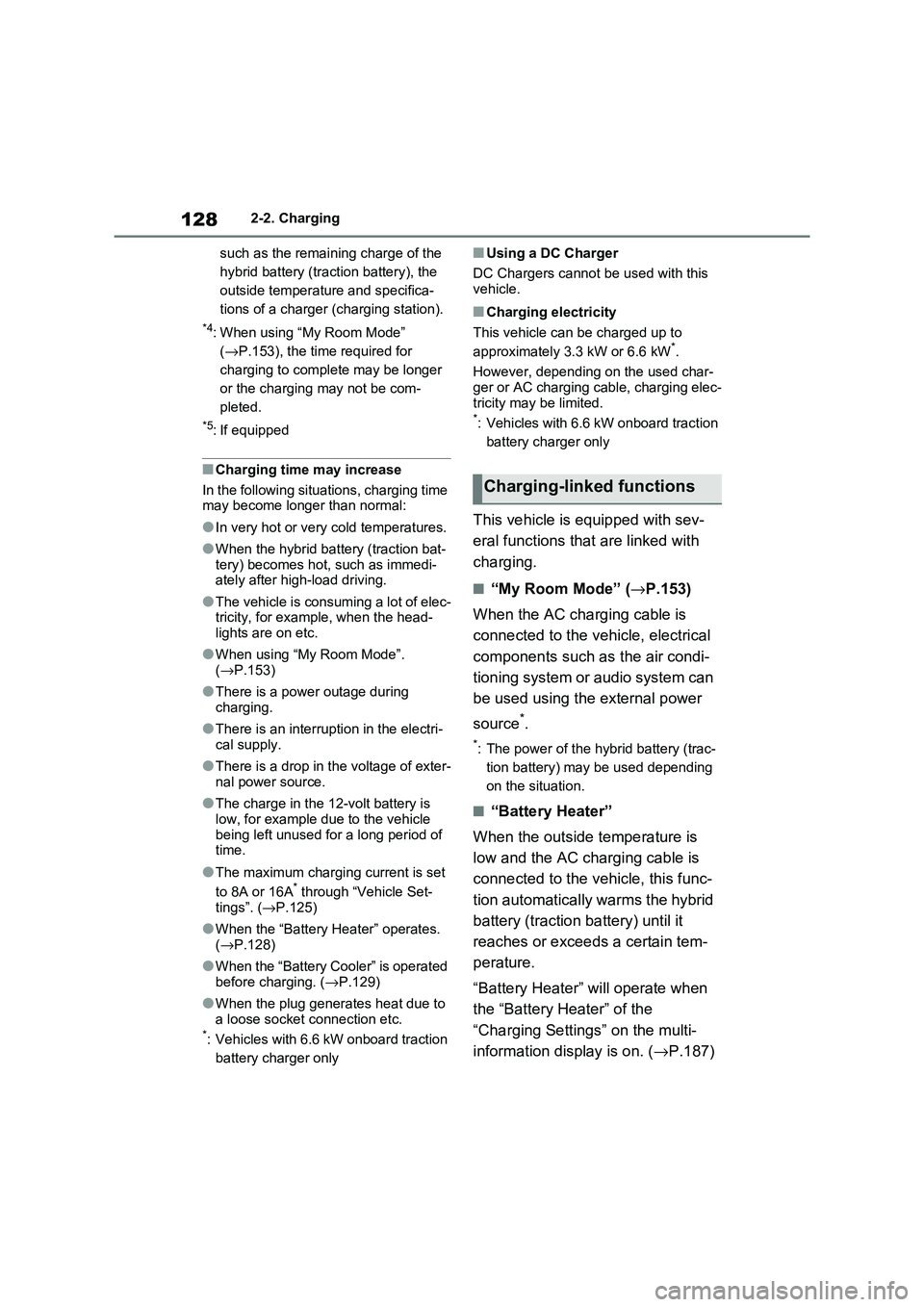
1282-2. Charging
such as the remaining charge of the
hybrid battery (traction battery), the
outside temperature and specifica -
tions of a charger (charging station).
*4: When using “My Room Mode”
( →P.153), the time required for
charging to complete may be longer
or the charging may not be com -
pleted.
*5: If equipped
■Charging time may increase
In the following situations, charging time may become longer than normal:
●In very hot or very cold temperatures.
●When the hybrid bat tery (traction bat-
tery) becomes ho t, such as immedi- ately after high-load driving.
●The vehicle is consuming a lot of elec - tricity, for example, when the head -
lights are on etc.
●When using “My Room Mode”.
( →P.153)
●There is a power outage during
charging.
●There is an interrup tion in the electri-
cal supply.
●There is a drop in t he voltage of exter- nal power source.
●The charge in the 12-volt battery is low, for example due to the vehicle
being left unused fo r a long period of
time.
●The maximum charging current is set
to 8A or 16A* through “Vehicle Set -
tings”. ( →P.125)
●When the “Battery Heater” operates.
( →P.128)
●When the “Battery Cooler” is operated
before charging. ( →P.129)
●When the plug generates heat due to
a loose socket connection etc.*: Vehicles with 6.6 kW onboard traction
battery charger only
■Using a DC Charger
DC Chargers cannot be used with this vehicle.
■Charging electricity
This vehicle can be charged up to
approximately 3. 3 kW or 6.6 kW*.
However, depending on the used char -
ger or AC charging cable, charging elec -
tricity may be limited.*: Vehicles with 6.6 kW onboard traction
battery charger only
This vehicle is equipped with sev -
eral functions that are linked with
charging.
■“My Room Mode” ( →P.153)
When the AC charging cable is
connected to the vehicle, electrical
components such as the air condi -
tioning system or audio system can
be used using the external power
source*.
*: The power of the hybrid battery (trac -
tion battery) may be used depending
on the situation.
■“Battery Heater”
When the outside temperature is
low and the AC cha rging cable is
connected to the vehicle, this func -
tion automatically warms the hybrid
battery (traction battery) until it
reaches or exceeds a certain tem -
perature.
“Battery Heater” will operate when
the “Battery Heater” of the
“Charging Settings” on the multi-
information display is on. ( →P.187)
Charging-linked functions
Page 135 of 666

133
2
2-2. Charging
Plug-in hybrid system
This vehicle has been designed to
allow charging from an external
power source using a AC charging
cable for exclusive use with stan -
dard household AC sockets.
However, the vehicle differs greatly
from standard household electrical
goods in the following ways, and
incorrect usage could cause fire or
electric shock, possibly leading to
death or serious injury.
The charging operation is
designed to ope rate at 8A-10A
continuously for the charge dura -
tion (approximately 9 hours).
( →P.127)
Charging can be conducted out-
doors.
To charge properly, follow the pro -
cedure after reading the explana -
tion below. Charging is intended to
be carried out by licensed drivers
only who properly understand the
charging procedure.
Do not allow children to use the
AC charging cable without
supervision. Also, keep the AC
charging cable out of reach of
infants.
When charging with a charger,
follow the procedures for using
each charger.
When charging using a public
charging facility, check the set -
ting of the charging schedule
function.
• When the charging schedule is regis -
tered, temporarily turn off the function
or turn “Charge Now” on. ( →P.145)
• When the charging schedule is set to
on, charging will not start even if the
AC charging cable is connected.
Also, charging fee may occur due to
connection of the A C charging cable.
Before charging, always check the
following items.
The parking brake is applied.
( →P.326)
Lights such as the headlights,
emergency flashers and interior
lights etc. are turned off.
If these light switche s are turned on,
then these features will consume elec-
tricity, and charging time will increase.
The power switch is turned to
OFF. ( →P.320)
Before charging, make sure that
WARNING
■When the AC charging cable is
connected to the vehicle
Do not operate the shift lever.
In the unlikely event that the AC
charging cable ha s been damaged,
the shift position may change from P to another positio n and the vehicle
could move, possibly leading to an
accident.
Charging precautions
Confirm the following before
charging
Inspecting the AC charging
cable
Page 156 of 666
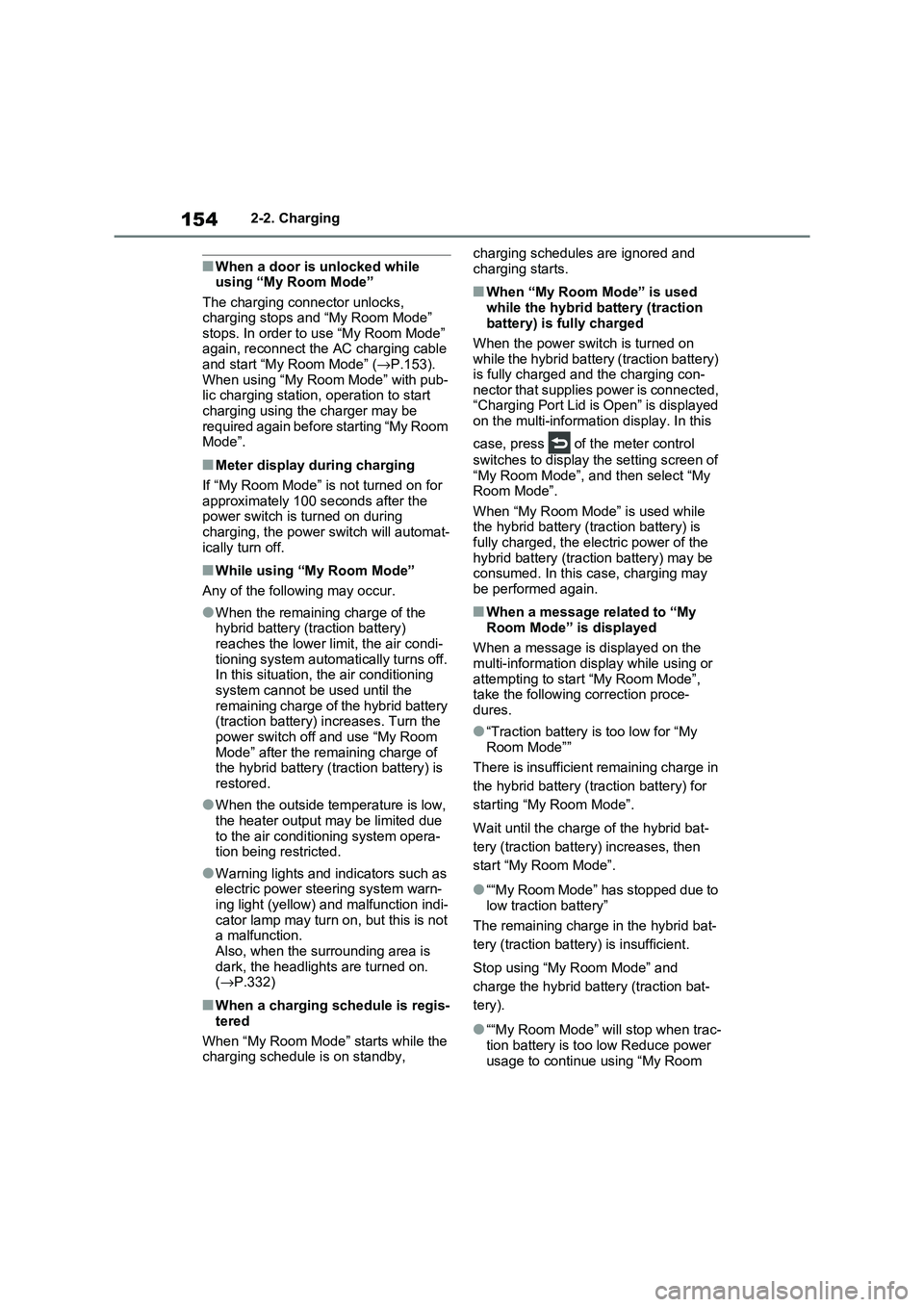
1542-2. Charging
■When a door is unlocked while using “My Room Mode”
The charging connector unlocks,
charging stops and “My Room Mode” stops. In order to use “My Room Mode”
again, reconnect the AC charging cable
and start “My Room Mode” ( →P.153). When using “My Room Mode” with pub -
lic charging station, operation to start
charging using the charger may be required again before starting “My Room
Mode”.
■Meter display during charging
If “My Room Mode” is not turned on for approximately 100 seconds after the
power switch is turned on during
charging, the power switch will automat- ically turn off.
■While using “My Room Mode”
Any of the follo wing may occur.
●When the remaining charge of the
hybrid battery (traction battery)
reaches the lower l imit, the air condi- tioning system automat ically turns off.
In this situation, the air conditioning
system cannot be us ed until the remaining charge of the hybrid battery
(traction battery) increases. Turn the
power switch off and use “My Room Mode” after the remaining charge of
the hybrid battery ( traction battery) is
restored.
●When the outside te mperature is low,
the heater o utput may be limited due
to the air conditioning system opera - tion being restricted.
●Warning lights and indicators such as electric power steering system warn -
ing light (yellow) and malfunction indi -
cator lamp may turn on, but this is not a malfunction.
Also, when the surrounding area is
dark, the headlight s are turned on. ( →P.332)
■When a charging schedule is regis-
tered
When “My Room Mode” starts while the charging schedule is on standby,
charging schedules are ignored and
charging starts.
■When “My Room Mode” is used while the hybrid battery (traction
battery) is fully charged
When the power switch is turned on while the hybrid battery (traction battery)
is fully charged and the charging con -
nector that supplies power is connected, “Charging Port Lid i s Open” is displayed
on the multi-informati on display. In this
case, press of th e meter control
switches to display the setting screen of “My Room Mode”, and then select “My
Room Mode”.
When “My Room Mode ” is used while the hybrid battery ( traction battery) is
fully charged, the ele ctric power of the
hybrid battery (trac tion battery) may be consumed. In this case, charging may
be performed again.
■When a message related to “My
Room Mode” is displayed
When a message is displayed on the
multi-information display while using or
attempting to start “My Room Mode”, take the following correction proce -
dures.
●“Traction battery is too low for “My
Room Mode””
There is insufficient remaining charge in
the hybrid battery ( traction battery) for
starting “My Room Mode”.
Wait until the charge of the hybrid bat-
tery (traction batter y) increases, then
start “My Room Mode”.
●““My Room Mode” has stopped due to
low traction battery”
The remaining charge in the hybrid bat -
tery (traction battery) is insufficient.
Stop using “My Room Mode” and
charge the hybrid battery (traction bat -
tery).
●““My Room Mode” will stop when trac -
tion battery is too low Reduce power
usage to continue using “My Room
Page 167 of 666
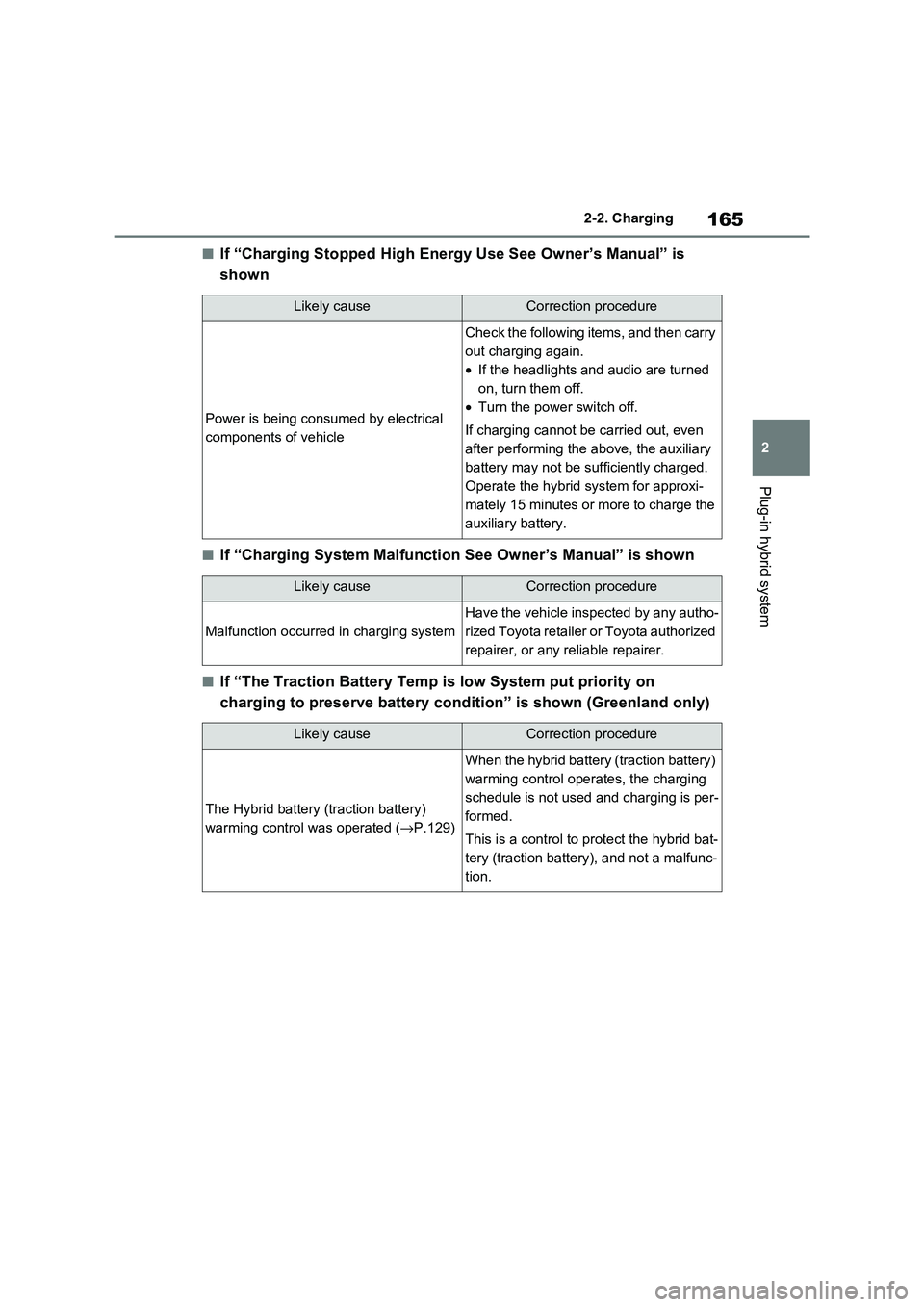
165
2
2-2. Charging
Plug-in hybrid system
■If “Charging Stopped High Energy Use See Owner’s Manual” is
shown
■If “Charging System Malfunction See Owner’s Manual” is shown
■If “The Traction Battery Temp is low System put priority on
charging to preserve battery co ndition” is shown (Greenland only)
Likely causeCorrection procedure
Power is being consumed by electrical
components of vehicle
Check the following items, and then carry
out charging again.
• If the headlights and audio are turned
on, turn them off.
• Turn the power switch off.
If charging cannot be carried out, even
after performing the above, the auxiliary
battery may not be s ufficiently charged.
Operate the hybrid system for approxi-
mately 15 minutes or more to charge the
auxiliary battery.
Likely causeCorrection procedure
Malfunction o ccurred in charging system
Have the vehicle inspected by any autho-
rized Toyota retailer or Toyota authorized
repairer, or any reliable repairer.
Likely causeCorrection procedure
The Hybrid battery (traction battery)
warming control was operated (→P.129)
When the hybrid battery (traction battery)
warming control opera tes, the charging
schedule is not used and charging is per -
formed.
This is a control to p rotect the hybrid bat-
tery (traction battery), and not a malfunc -
tion.